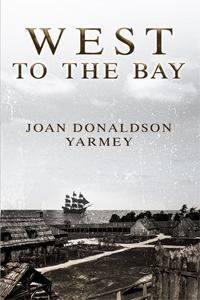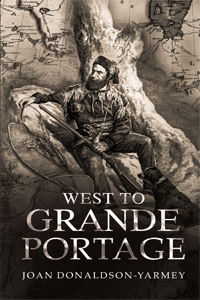
https://books2read.com/West-to-the-Bay-Yarmey

https://books2read.com/West-to-Grande-Portage-V2
https://bwlpublishing.ca/donaldson-yarmey-joan/
I am a proud Canadian author of over twenty fiction and non-fiction books in my long writing career. But I am just one of thousands of published writers from this huge country. Canada has had a long and illustrious history of producing world renown authors and books going all the way back to the 18th century.
Frances Moore was born in England in 1724. She was a well-known poet and playwright in England before she and her husband, Reverend John Brooke moved to Quebec City in 1763, for John to take up the post of army chaplain. During her time there Frances wrote The History of Emily Montague, a love story set in the newly formed Quebec province.
The story is told through the voices of her characters by way of personal letters between the two. This is known as epistolary (of letters) type of writing and it was popular during the1700s in Europe. The Brookes’ returned to England in 1768 and the novel was published in 1769 the London bookseller, James Dodsley. The History of Emily Montague was the first novel written in what is now Canada and the first with a Canadian setting. Frances died in 1789.
Prince Edward Island
Lucy Maud Montgomery was born in Clifton, now New London, Prince Edward Island on November 30, 1874. Her mother died of tuberculosis two months before Lucy’s second birthday. Lucy was put in the custody of her maternal grandparents in Cavendish by her father who later moved to Prince Albert in what is now Saskatchewan.
This was a very lonely time for Lucy. She spent much of her childhood alone so she created imaginary friends and worlds. Lucy kept a diary and when she was thirteen years-of-age, she wrote that she had early dreams of future fame. After completing her education Lucy moved to Prince Albert and spent a year with her father and step-mother. While there she had two poems published in The Daily Patriot, the Charlottetown newspaper.
Lucy returned to Cavendish and obtained her teacher’s license, completing the two year course in one year. She went on to study literature at Dalhousie University in Halifax, Nova Scotia. She worked as a teacher which gave her time to write. From 1897 to 1907 she had over one hundred stories published in magazines and newspapers.
Lucy had a number of suitors over the years and turned down two marriage proposals, one because he was narrow-minded, the other because he was just a good friend. She finally accepted a proposal from Edwin Simpson in 1897 but came to dislike him. She found herself in love with another man, Herman Leard. She refused to have sex with him but they did become quite passionate in their kissing and petting. She finally stopped seeing Herman in 1898 and was upset when he died of influenza in 1899. She also broke off her engagement to Edwin Simpson.
Ms. Montgomery moved back to Cavendish to look after her ailing grandmother and began writing novels. Her first novel, Anne of Green Gables, was published in June of 1908 under the name L.M. Montgomery and was an instant success, going through nine printings by November of 1909. Lucy stayed in Cavendish until her grandmother’s death in March 1911 and shortly after she married Ewen (Ewan) Macdonald. Ewen was a Presbyterian minister and they moved to Leaskdale in present-day Uxbridge Township in Ontario where he took the position of minister at St. Paul’s Presbyterian Church. The lived in the Leaskdale manse and she wrote her next eleven books while there.
Lucy and Ewen had three children, the second one being stillborn. Lucy’s second book, Anne of Avonlea was published in 1909 and The Story Girl, came out in 1911. She went through several periods of depression and suffered from migraine headaches while her husband had attacks of a major depressive order and his health suffered. She almost died from the Spanish flu in 1918, spending ten days in bed. She began an Emily trilogy with Emily of New Moon in 1923.
When Ewen retired in 1935, they bought a house in Swansea, Ontario, a suburb of Toronto which she named Journey's End.
On April 24, 1942, Lucy Maud Montgomery was found dead in her bed in her Toronto home. The primary cause of death recorded on her death certificate was coronary thrombosis. Montgomery was buried at the Cavendish Community Cemetery in Cavendish. In 2008, Lucy’s granddaughter, Kate Macdonald Butler, said that because of her depression she may have taken her own life through a drug overdose.
Writing was Lucy’s comfort and besides the nine books of the Anne series she wrote twelve other novels and had four short story collections published. Nineteen of her books were set in Prince Edward Island and she immortalized the small province with her descriptions of the people and community. Each year, hundreds of thousands of people from around the world, come to Prince Edward Island to see the place that Lucy loved so much, and to visit Green Gables, the house and farm where ‘Anne grew up.’
Lucy Maud Montgomery was made an officer of the Order of the British Empire (OBE) by King George V in 1935. She was given a special medal, which she could only wear out in public in the presence of the King or one of his representatives such as the Governor-General. Montgomery was named a National Historic Person in 1943 by the Canadian Federal government. On May 15, 1975, the Canadian Post issued a stamp to Lucy Maud Montgomery, Anne of Green Gables. The Leaskdale Manse was designated a National Historic Site in 1997. Green Gables, was formally recognized as "L. M. Montgomery's Cavendish National Historic Site" in 2004.
In terms of sales, both in her lifetime and since, Montgomery is the most successful Canadian author of all time.
Milton James Rhode Acorn was born in Charlottetown, Prince Edward Island, on March 30, 1923. At the age of eighteen, he joined the armed forces and was stationed mainly in England. On an ocean crossing, he was injured as a result of depth charges. He returned home and received a disability pension. He moved to Montreal in 1956 where he self-published a chapbook of his poems titled, In Love and Anger. His poetry was also published in New Frontiers, a political magazine, and in Canadian Forum magazine.
Milton moved to Vancouver in the mid-1960s and helped found the ‘underground’ newspaper, Georgia Straight, in 1967. The newspaper is still in publication. His collection of poetry I’ve Tasted My Blood, was published in 1969 and he received the Canadian Poets Award in 1970. He wrote three more books of poetry and in 1976 received the Governor General’s Award for The Island Means Minago.
Acorn liked to be a man of mystery. He disguised and altered his background so that biographers and anyone wanting to find out more about him did not learn anything that he did not want uncovered. Because of the many different versions he told of his life it is difficult to know where reality ended and fiction began. He was also considered to be a hostile and quarrelsome man. However, Milton Acorn was deemed to be one of Canada most well-known poets by the early 1970s. Thirteen collections of poetry were published before his death and five more were published posthumously.
Three documentaries were made about Milton Acorn: Milton Acorn: The People’s Poet (1971; In Love and Anger: Milton Acorn-Poet (1984); and A Wake for Milton (1988).
Milton suffered diabetes and moved back to Prince Edward Island in 1981. He had a heart attack in July 1986 and died on August 20, due to complications from the diabetes and his heart attack.
Milton Acorn was known as the ‘People’s Poet’. The Milton Acorn People’s Poetry Award was established in his memory in 1987. It consists of $500 and a medallion and is given to an exceptional ‘People’s Poet.’































